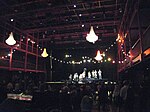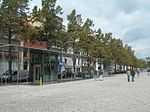Het Zinneke

Het Zinneke (Brusselian dialect for "the mutt"), sometimes called Zinneke Pis by analogy with Manneken Pis, is a bronze sculpture in central Brussels, Belgium, erected in 1998. Created by Tom Frantzen, it represents a urinating dog, along the same lines as Manneken Pis (a boy) and its derivative Jeanneke Pis (a girl). It is an example of folk humour (zwanze) popular in Brussels.Het Zinneke is located at the junction of the Rue des Chartreux/Kartuizersstraat and the Rue du Vieux-Marché-aux-Grains/Oude Graanmarkt in the City of Brussels, not far from the Halles Saint-Géry/Sint-Gorikshallen, a former covered market, and one of the trendiest districts of the capital. In August 2015, Het Zinneke was struck by a car, and was restored by the sculptor.
Excerpt from the Wikipedia article Het Zinneke (License: CC BY-SA 3.0, Authors, Images).Het Zinneke
Rue du Vieux Marché aux Grains - Oude Graanmarktstraat, City of Brussels Pentagon (Brussels)
Geographical coordinates (GPS) Address Phone number Website Nearby Places Show on map
Geographical coordinates (GPS)
| Latitude | Longitude |
|---|---|
| N 50.848772 ° | E 4.345585 ° |
Address
Think Twice
Rue du Vieux Marché aux Grains - Oude Graanmarktstraat 48
1000 City of Brussels, Pentagon (Brussels)
Belgium
Open on Google Maps









